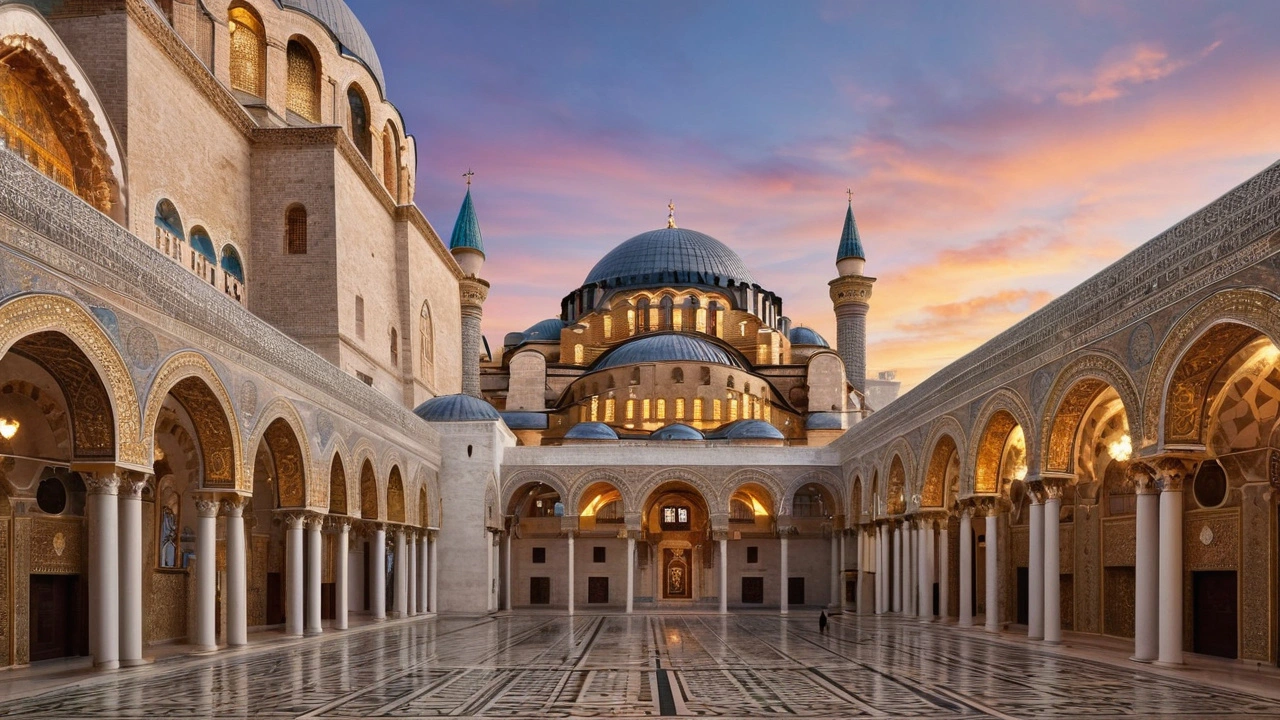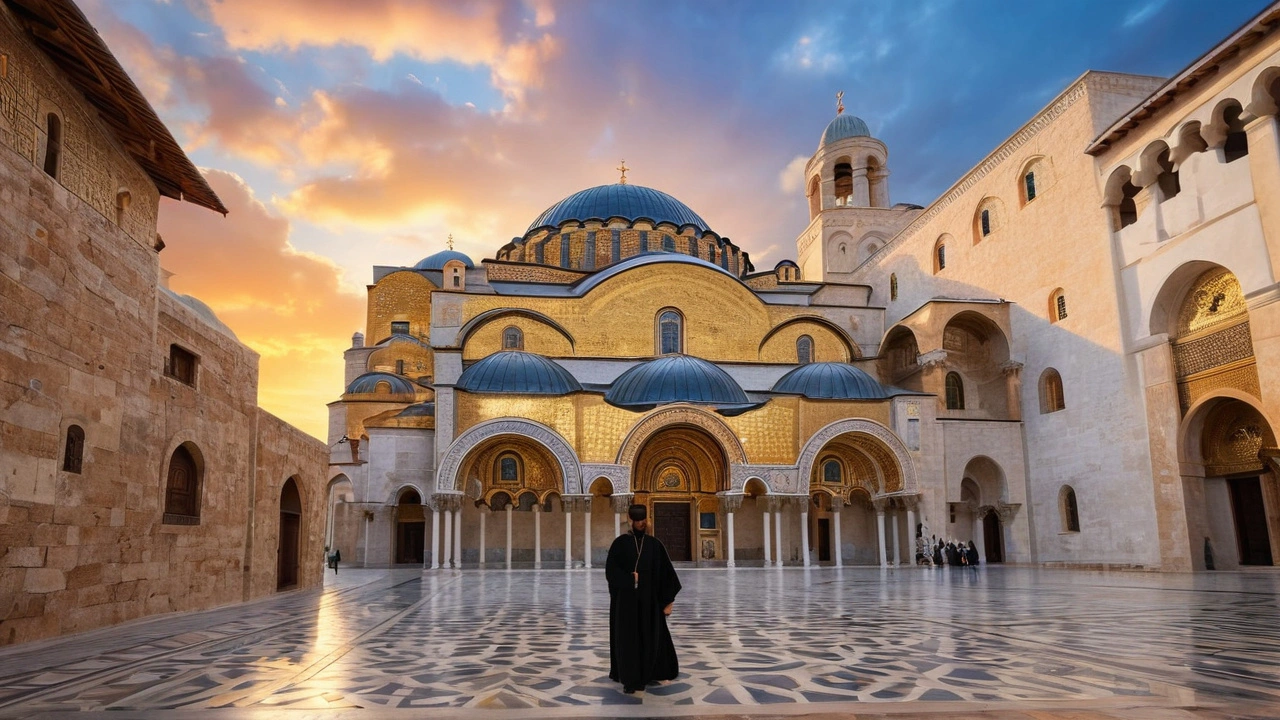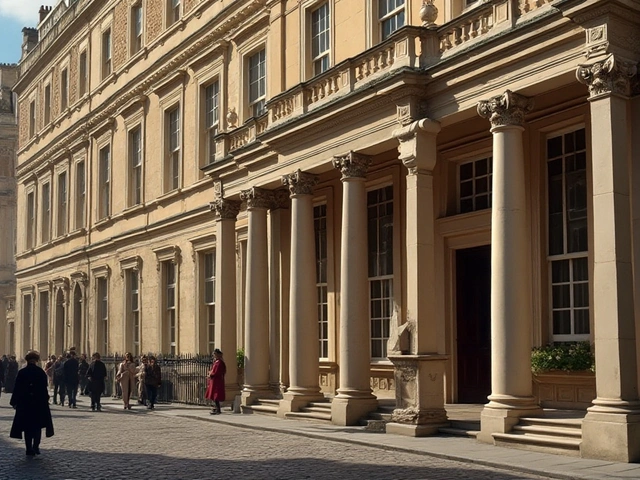Byzantine Architecture is a fascinating field that represents a splendid blend of different cultural influences. Emerging from the Roman Empire’s decay, it bore witness to a time of profound change and cultural fusion.
In our exploration, we will embark on a journey through the origins, the unique features, the iconic buildings, and the lasting impact of Byzantine architecture. By examining these elements, we hope to glimpse into a world where art and culture seamlessly merge to craft something truly extraordinary.
Origins and Influences
The story of Byzantine architecture begins with the decline of the Roman Empire and the rise of the Byzantine Empire, which emerged as a stronghold of Christianity and culture. Founded in 330 AD by Emperor Constantine I, Byzantium was strategically located at the crossroads of Europe and Asia. Its position made it a melting pot of various cultures, incorporating elements from Roman, Greek, Persian, and even Islamic art and architecture.
One of the most significant influences on Byzantine architecture was Roman engineering. The Byzantines inherited the use of the basilica form, which was initially used for public buildings in Rome. However, they transformed it into a structure suited for Christian worship, leading to the creation of expansive churches with vast domes, such as the famous Hagia Sophia in Constantinople. The use of the dome became a defining feature of Byzantine design, symbolizing the heavens and the divine.
Another crucial influence came from Eastern traditions. The Sassanian Empire (modern-day Iran) was known for its intricate brickwork and ornamental stucco reliefs, which the Byzantines adapted and refined. Additionally, the Byzantine Empire had extensive trade connections with the Islamic world, resulting in a synthesis of artistic styles and the incorporation of Arabic geometric patterns and ornate calligraphy into their architecture.
Art historian Cyril Mango once wrote, “The Byzantines were not so much innovators as they were exceptional synthesizers. They took the best elements from different cultures and fused them into a unique and enduring architectural style.” This blend of multiple cultural influences is evident in the richly decorated mosaics that adorned Byzantine churches, featuring Christian iconography rendered with a finesse that spoke of both Roman naturalism and Eastern abstraction.
The religious context of the Byzantine Empire also played a crucial role in shaping its architectural style. As Christianity became the state religion, there was a need to build grand ecclesiastical structures that could accommodate large congregations and reflect the glory of God. This era saw the rise of intricate mosaics, painted frescoes, and detailed iconostasis, all aimed at creating a heavenly realm on earth.
Moreover, the political strategies of the Byzantine rulers influenced architectural trends. They often commissioned large building projects to showcase their power and piety. Emperor Justinian I, for instance, was known for his ambitious architectural pursuits, with the Hagia Sophia being one of his most significant legacies. His reign marked a golden age for Byzantine architecture, characterized by monumental structures and artistic innovation.
Thus, the origins and influences of Byzantine architecture are as complex as the empire itself. By synthesizing various cultural elements and adapting them to serve new purposes, the Byzantines created an architectural style that was both distinct and deeply reflective of their historical and cultural milieu. The lasting impact of their architectural innovations continues to be felt in modern times, serving as a testament to their ingenuity and artistic vision.

Distinctive Features
Byzantine architecture stands out with its unique blend of Roman engineering and Greek aesthetics, blended with Near Eastern decorative influences. One of the most notable elements is the use of the central dome, often placed over a square base. This technique was perfected through the use of pendentives, which are triangular sections of a sphere, enabling the circular dome to be supported on a square structure. This innovation allowed for expansive, open and luminous interiors, providing a sense of vastness and divinity.
The material choice in Byzantine architecture was strategic and artistic. Builders often utilized a combination of brick and stone, creating visually appealing textures and patterns. The walls were frequently covered with intricate mosaics, made from small pieces of colored glass or stone. These mosaics often depicted religious scenes, saints, and other divine figures, serving both decorative and didactic purposes. The use of light in these structures was also a distinctive feature. Windows were often placed to illuminate the mosaics, creating a mystical atmosphere that enhanced the spiritual experience. This thoughtful use of light can be observed in Hagia Sophia, perhaps the most emblematic Byzantine structure.
The doorways and arcades in Byzantine buildings often featured elaborate carvings and detailed stonework. Capitals on columns were richly decorated with intricate designs, usually with floral or geometric patterns, that drew from a range of artistic traditions. Another significant trait is the emphasis on verticality. The structures often aimed to draw the gaze upward, symbolizing a connection to the divine. This effect was achieved not just through the towering domes, but also through the use of tall, narrow windows and elongated interior spaces.
A noteworthy aspect of Byzantine churches is the use of domical vaults and cross-in-square plans, which became symbolic of Byzantine ecclesiastical architecture. These spaces provided a centralized plan that was seen as an earthly reflection of the heavenly order. The interior space was designed to guide visitors on a spiritual journey; entering through narthex, moving into the naos, and finally reaching the apse, where the altar was positioned.
John Julius Norwich, a famed historian, once remarked, “The Byzantine art is an art of engineers; its beauty derives not from its decoration, but from its structure.” His words underline how the ingenuity behind the architectural techniques was an art form in itself.
In essence, the distinctive features of Byzantine architecture were not merely aesthetic choices, but rather deliberate integrations of various cultural influences, each adding to the structural and spiritual grandeur of the buildings. The legacy of these characteristics is visible even today, as modern architects often draw inspiration from Byzantine techniques and aesthetics.

Famous Byzantine Structures
When we talk about Byzantine architecture, it is impossible to ignore the legendary Hagia Sophia in Istanbul. This iconic monument, originally built as a cathedral in the 6th century, stands as a testimony to the engineering and artistic prowess of the Byzantine era. Its massive dome, an architectural marvel of its time, presents a breathtaking sight as it seems to float effortlessly above the central space. Procopius, a historian of that era, famously noted, "It seemed not to be founded on solid masonry, but suspended from heaven by that golden chain and so to cover the space."
Another notable example is the San Vitale in Ravenna, Italy. This church, built in the early 6th century, is renowned for its complex, octagonal plan and rich mosaic decorations. The mosaics depicting Emperor Justinian and Empress Theodora with their retinues are among the most significant art pieces from this period. These mosaics not only display the grandeur of the imperial court but also provide a window into the political and religious hierarchies of the time.
In Thessaloniki, the Church of Saint Demetrios is a splendid testament to the influence of Byzantine architecture. Rebuilt in the 7th century after a fire, it features a basilica layout with stunning mosaics, depicting Saint Demetrios, the patron saint of the city, and various historical scenes. The combination of religious imagery and local historical figures offers a unique insight into the regional adaptations of Byzantine design.
The Basilica of Saint Mark in Venice, often referred to as the "Church of Gold," highlights the long-lasting influence of Byzantine artistic achievements. Constructed in the 11th century, its opulent decoration with gold mosaics and intricate carvings reflects the deep cultural connections between the Byzantine Empire and the Venetian Republic. This synthesis of Eastern and Western design principles makes it one of the most visited and admired architectural sites in Europe.
Beyond these, there are numerous other lesser-known yet profoundly significant structures scattered throughout the former Byzantine Empire. For example, the Church of Saint Catherine in Mount Sinai houses ancient manuscripts and icons, serving as both a religious site and a repository of Byzantine artistry and literature.
Overall, these famous Byzantine structures not only display the architectural innovation and artistic skill of their builders, but also tell the story of a culture where faith, politics, and art were deeply intertwined. They continue to inspire and inform contemporary architecture and design, proving that the legacy of the Byzantine Empire is very much alive today.

Legacy and Modern Relevance
Byzantine Architecture has left an indelible mark on the world, not just as a relic of the past, but as a living legacy that continues to inspire contemporary design. Even after centuries, the grandeur and artisanship of Byzantine structures are reflected in modern buildings. These influences are easy to spot if you know where to look.
Take, for instance, the Hagia Sophia in Istanbul. Originally constructed as a cathedral, it showcases a blend of Roman engineering and Greek artistic traditions. Its vast domes and intricate mosaics have inspired countless architects. In fact, many modern churches, civic buildings, and even homes borrow design elements from Byzantine architecture, including domes, arches, and the use of natural light to create a sense of space and divinity.
In an age where sustainability is key, Byzantine architecture’s use of local materials offers valuable lessons. The Byzantines often sourced their building materials locally, minimizing transportation costs and environmental impact. This practice is being echoed today by architects committed to sustainable design. Local sourcing not only supports regional economies but also helps in reducing carbon footprints, a concern resonating strongly in our time.
A fascinating modern example is the Cathedral of Brasília in Brazil. Designed by Oscar Niemeyer, it employs sweeping curves and extensive use of glass reminiscent of Byzantine techniques, blending modernity with ancient wisdom. The cathedral’s design pays homage to Byzantine aesthetics while utilizing modern materials and construction techniques. Such adaptations ensure that Byzantine concepts continue to find resonance in contemporary architecture.
Additionally, Brook Wilensky-Lanford aptly writes, “The spirit of Byzantine architecture lives on in every structure that seeks to communicate a sense of higher purpose and connection through its design.”
“The spirit of Byzantine architecture lives on in every structure that seeks to communicate a sense of higher purpose and connection through its design.”Her words encapsulate the enduring emotional impact of this architectural style. The Byzantine use of grand spaces to invoke a sense of the divine continues to be a powerful tool in modern design, fostering an emotional connection between the space and its occupants.
From an educational perspective, Byzantine architecture is a treasure trove for historians and architects alike. University curriculums around the world include courses specifically on Byzantine art and architecture, highlighting its educational importance. These studies assist students in understanding the evolution of architectural practices and encourage them to draw inspiration from this ancient yet ever-relevant style.
The digital age has also seen a resurgence in interest towards Byzantine architecture, thanks to virtual tours and augmented reality experiences. Digital platforms offer a way for people to explore and appreciate these ancient marvels from the comfort of their homes. It’s thrilling to think that the digital tools of today might be used to preserve and spread the appreciation for Byzantine structures worldwide.
In summary, Byzantine architecture is not just a historical artifact but a continuous source of inspiration and practical wisdom. Its principles have transcended time, influencing modern architecture and sustainable practices. By understanding and appreciating Byzantine design, we can enrich our contemporary architectural landscape while honoring a profound and beautiful legacy.




